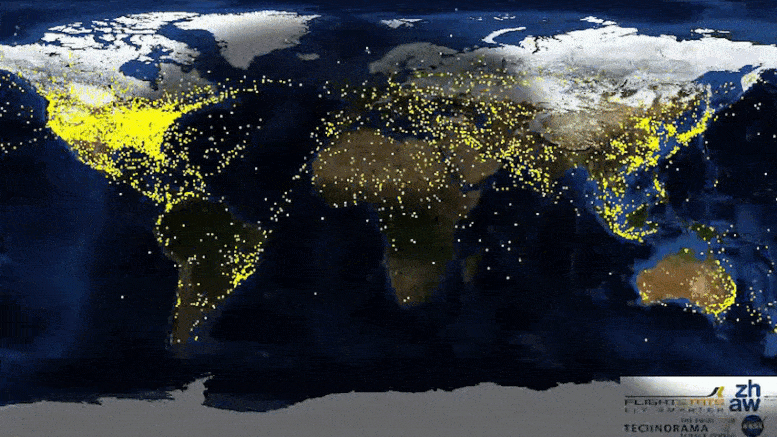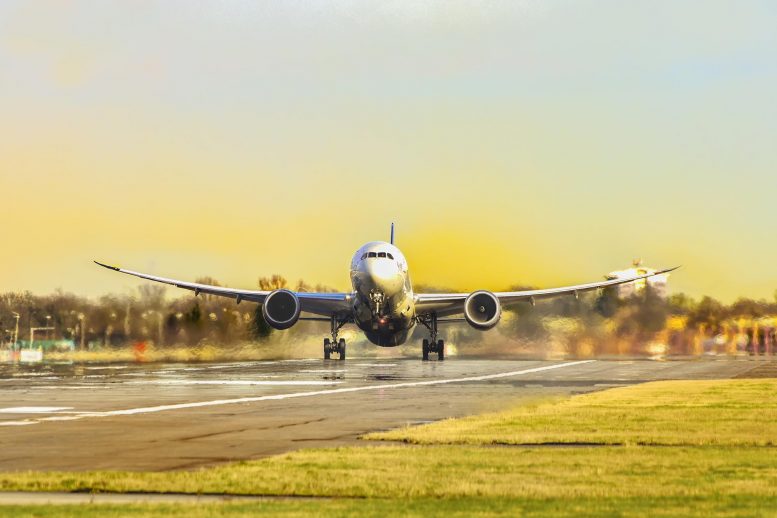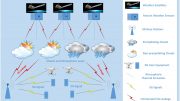Weather forecasts have become less accurate during the COVID-19 pandemic due to the reduction in commercial flights, according to new research.
A new study in AGU’s journal Geophysical Research Letters finds the world lost 50-75% of its aircraft weather observations between March and May of this year, when many flights were grounded due to the COVID-19 pandemic.
Aircraft typically inform weather forecasts by recording information about air temperature, relative humidity, air pressure and wind along their flight path. With significantly fewer planes in the sky this spring, forecasts of these meteorological conditions have become less accurate and the impact is more pronounced as forecasts extend further out in time, according to the study, which is part of an ongoing special collection of research in AGU journals related to the current pandemic.

This animation, created in 2008 by the Zurich University of Applied Sciences, shows global air traffic over the course of a day. Credit: ZHAW School of Engineering.
Weather forecasts are an essential part of daily life, but inaccurate forecasts can also impact the economy, according to Ying Chen, a senior research associate at the Lancaster Environment Centre in Lancaster, United Kingdom and lead author of the new study. The accuracy of weather forecasts can impact agriculture as well as the energy sector and stability of the electrical grid. Wind turbines rely on accurate forecasts of windspeed and energy companies depend on temperature forecasts to predict what the energy load will be each day as people crank up their air conditioning.
“If this uncertainty goes over a threshold, it will introduce unstable voltage for the electrical grid,” Chen said. “That could lead to a blackout, and I think this is the last thing we want to see in this pandemic.”
The regions most impacted by the reduction in weather forecasts have been those with normally heavy air traffic, like the United States, southeast China and Australia, as well as isolated regions like the Sahara Desert, Greenland and Antarctica. Western Europe is a notable exception: its weather forecasts have been relatively unaffected despite the number of aircraft over the region dropping by 80-90%.
This was surprising, Chen said. Chen suspects the region has been able to avoid inaccuracies because it has a densely-packed network of ground-based weather stations and balloon measurements to compensate for the lack of aircraft.
“It’s a good lesson which tells us we should introduce more observation sites, especially in the regions with sparse data observations,” Chen said. “This will help us to buffer the impacts of this kind of global emergency in the future.”
Chen also found precipitation forecasts around the world have not been significantly affected, because rainfall forecasts have been able to rely on satellite observations. But March, April and May have been relatively dry this year in most of the world, so Chen cautions that precipitation forecasts could potentially suffer as the hurricane and monsoon seasons arrive.
Comparing forecasts
Forecast models are more accurate when a greater number of meteorological observations are taken into account, and the number of observations is greatly diminished when fewer planes are in the air, as was the case in March-May of this year. The Aircraft Meteorological Data Relay program is comprised of over 3,500 aircraft and 40 commercial airlines, which typically provide over 700,000 meteorological reports a day.
When Chen compared the accuracy of weather forecasts from March-May 2020 to the same periods in 2017, 2018 and 2019, he found the 2020 forecasts were less accurate for temperature, relative humidity, windspeed and air pressure. This is despite the fact that in February, before flights were significantly impacted, weather forecasts were more accurate than in previous years.
He found surface pressure and wind speed forecasts were unaffected in the short term (1-3 days) but were less accurate for the longer-term (4-8 days) forecasts included in the study. In February, before the number of flights dropped off, forecast accuracy in several regions that rely on aircraft observations had actually improved by up to 1.5 degrees Celsius (35 degrees Fahrenheit) over previous years. But in March-May 2020, when flights were reduced by 50-75% compared to February, that improvement in accuracy vanished.
Chen found western Europe was the only region with normally high flight traffic that did not suffer remarkably reduced accuracy in temperature forecasts. He attributed this to over 1,500 meteorological stations that form a dense data collection network in the area.
However, European weather was particularly unvarying over the March-May 2020 time period, making it easier to forecast with less data, according to Jim Haywood, a professor of atmospheric science at the University of Exeter, United Kingdom, who was not involved with the new study. Haywood suspects this played a role in the persisting accuracy of western European forecasts in addition to the network of ground observation points.
The longer forecasters lack aircraft data, the more weather forecasts will be impacted, according to the study. While precipitation forecasts have so far been unaffected, scientists’ ability to catch early warning signs of extreme weather events this summer could suffer. In the long term, the study results suggest sources of weather data should be diversified, especially in observation-sparse areas and areas that rely heavily on commercial flights, according to Chen.
Reference: “COVID‐19 Pandemic Imperils Weather Forecast” by Ying Chen, 15 July 2020, Geophysical Research Letters.
DOI: 10.1029/2020GL088613










The American Geophysical Union really should better understand temperature conversions between the celcius and fahrenheit scales! A temperature of 1.5 deg C may be about 35 deg F, but a DIFFERENCE of 1.5 deg C does not equal the same due to the 32 deg F offset between the scales. In this case it is just 2.7 deg F.
Please correct this article.
Why don’t they use CoCoRHaS network?
Nonsense. Please. always some new garbage going into peoples ears. Ffs. Most of the science community are full of it.